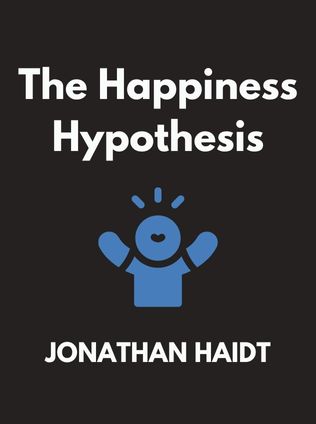
The Happiness Hypothesis
Finding Modern Truth in Ancient Wisdom
By Jonathan Haidt
Published 12/2006
About the Author
Jonathan Haidt, a prominent social psychologist and professor at New York University, is renowned for his research on the foundations of morality, happiness, and cultural psychology. His work seeks to uncover the underlying psychological mechanisms that drive human behavior and societal norms. Haidt's interest in understanding human nature is deeply rooted in ancient wisdom and philosophy, which he often juxtaposes with modern psychological theories to offer a more comprehensive view of human happiness and well-being.
Haidt’s book, The Happiness Hypothesis: Finding Modern Truth in Ancient Wisdom, is a masterful exploration of how ancient philosophical teachings align with contemporary psychological insights to provide a blueprint for a fulfilling life. Drawing from Eastern and Western philosophies, as well as modern psychological research, Haidt presents a balanced approach to understanding the complexities of happiness. His metaphor of the 'rider and the elephant' is a cornerstone of his work, illustrating the dynamic relationship between reason and emotion in the pursuit of happiness.
Main Idea
At its core, The Happiness Hypothesis is an exploration of the human quest for happiness and fulfillment, through the lens of both ancient wisdom and modern psychology. Haidt argues that neither pure reason nor unbridled emotion can lead to true happiness; rather, the key lies in balancing these two forces. The book delves into the ways in which our mental filters—shaped by both evolution and experience—affect our perceptions, emotions, and ultimately, our happiness.
Haidt’s central thesis is that happiness is not simply a matter of fulfilling desires or eliminating them, as some philosophical traditions might suggest. Instead, it’s about understanding the interplay between reason and emotion, and how they can be harmonized to achieve lasting fulfillment. He introduces the metaphor of the rider and the elephant to explain this dynamic: the rider represents reason, and the elephant represents emotion. While the rider can attempt to guide the elephant, the elephant’s sheer power and instinct often dictate the course.
Table of Contents
- Introduction: The Divided Self
- The Rider and the Elephant
- Changing Your Mind
- Reciprocity and the Human Condition
- The Pursuit of Happiness
- The Importance of Relationships
- The Role of Adversity
- Virtue and Character
- Finding the Sacred
- The Meaning of Life
Introduction: The Divided Self
Haidt begins by exploring the concept of the 'divided self,' a notion that has been present in various forms throughout history. He posits that the human mind is composed of different parts that often conflict with each other. This division is exemplified in the metaphor of the rider and the elephant. The rider, representing our conscious, rational mind, seeks to control the elephant, which embodies our emotional, automatic responses. The tension between these two aspects of ourselves is central to understanding human behavior and the pursuit of happiness.
The Rider and the Elephant
The metaphor of the rider and the elephant is one of the most striking elements of Haidt’s work. It encapsulates the ongoing struggle between reason and emotion. The rider, though seemingly in control, is often at the mercy of the elephant’s desires and impulses. Haidt emphasizes that true wisdom lies not in trying to dominate the elephant, but in learning to guide it effectively.
Haidt writes:
“The rider and the elephant are not enemies. They are partners who must learn to work together.” – Jonathan Haidt
This metaphor is not just a clever illustration; it reflects the complex interplay of our cognitive processes. The rider is analytical, deliberate, and future-oriented, while the elephant is instinctive, emotional, and driven by immediate needs. Understanding this relationship is crucial for achieving personal growth and happiness. Haidt suggests that instead of trying to suppress our emotions (the elephant), we should strive to understand and direct them, using the rational mind (the rider) as a guide.
Changing Your Mind
In this chapter, Haidt explores the concept of mental flexibility and the potential for personal growth. He argues that while our emotional responses (the elephant) are often quick and automatic, they are not fixed. Through practices like meditation, cognitive therapy, and mindfulness, we can retrain our minds to respond differently to stimuli, thereby altering our emotional landscape.
Sign up for FREE and get access to 1,400+ books summaries.
You May Also Like
The Subtle Art of Not Giving a F*ck
A Counterintuitive Approach to Living a Good Life
By Mark MansonRich Dad Poor Dad
What the Rich Teach Their Kids About Money - That the Poor and Middle Class Do Not!
By Robert T. KiyosakiHow To Win Friends and Influence People
The All-Time Classic Manual Of People Skills
By Dale CarnegieFreakonomics
A Rogue Economist Explores the Hidden Side of Everything
By Steven D. Levitt and Stephen J. Dubner



















